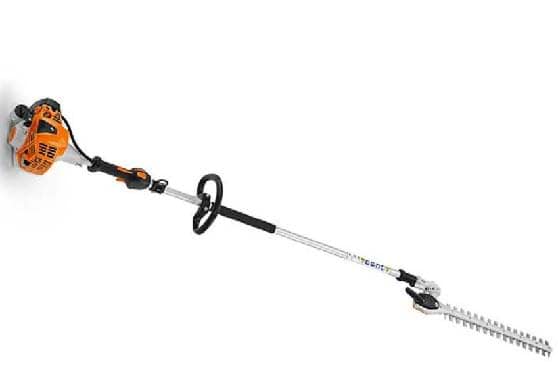Published 2024-01-09
Background
A gardener was conducting tree trimming work at a private residence in a low bushfire risk area (LBRA). The work was being performed by a gardener who was using an extendable pole mounted hedge trimmer (hedger) similar to that pictured below.
The gardener was pruning branches from the tree using a hedger with the intention of clearing branches around an insulated low voltage electric line (service wire). There was no safety observer on site. As the gardener was clearing vegetation from around the service wire, they cut through the service wire between the anchor point and the junction box. The service wire did not fall to the ground, however electricity supply to the property was affected.
The incident created an unsafe electrical situation that had the potential to cause property damage, serious personal injury or in the worst circumstance an electrocution. Fortunately, no one was injured.
The incident was reported to the electricity distribution business and to Energy Safe Victoria (Energy Safe).
Investigation findings
Energy Safe conducted an investigation of this incident and found:
- the gardener failed to maintain the Safe Approach Distance (SAD) to the insulated LV conductor when they pruned the tree
- the gardener did not identify and outline control measures to ensure the work could be completed safely.
Energy Safe’s view is that the combination of these failures means the gardener did not comply with the Electricity Safety (General) Regulations 2019 (the General Regulations), constituting a breach of Electricity Safety legislation; heavy penalties may be applied to such breaches.
Key lessons
- Ensure all site hazards are identified and actions to control the hazards are implemented
- Continually monitor site and environmental conditions and adjust work sequences and practices to adapt to changing conditions
- Always maintain appropriate SADs when undertaking works in the vicinity of live electrical apparatus
- Regularly reassess each worksite for hazards when completing electric line clearance work.
Important information
- Failing to identify hazards at a work site will place workers at risk of serious personal injury or in the worst circumstance, electrocution
- Ensure each individual work site is assessed for hazards and controls are implemented to manage risks; this should be an ongoing process throughout the work task to adapt to changing conditions
- Working near live high and low voltage electric lines is equally dangerous. A vegetation management worker was electrocuted in February 2019 when they made contact with uninsulated low voltage electric lines.
Enforcement outcomes
Having completed its investigation of this incident it is Energy Safe’s view that the minimum clearances from the electric line, as required by the General Regulations, were not maintained. Failing to maintain the minimum clearance is a breach of the General Regulations.
- ESV’s view is the gardener interfered with protected infrastructure, which is a breach of the General Regulations.
Energy Safe may choose to prosecute or take other enforcement action where it considers a breach of the Electricity Safety Act 1998 or Electricity Safety Regulations has occurred. Heavy penalties may be applied.
Download this Safety Alert
Date: 16/12/2025 9:37
Controlled document
The currency and accuracy of this document cannot be guaranteed once printed or saved to a storage device. If in doubt, please check the ESV website for the current version.
Reviewed
